Illuminate Adelaide festival shows winter in the city in a new light
From Australia’s hidden African history to botanical light displays, inflatable animals and alien orchestras, we meet the artists behind the new Illuminate Adelaide winter festival.
SA Weekend
Don't miss out on the headlines from SA Weekend. Followed categories will be added to My News.
Illumination meets innovation in the latest addition to South Australia’s ever-growing festival roster – but switching on the state’s biggest light show is only the start.
Technology, music, art, live performance and bold new ideas will all help to activate the city’s streets, squares, parks and venues as part of Illuminate Adelaide from July 16 to August 1.
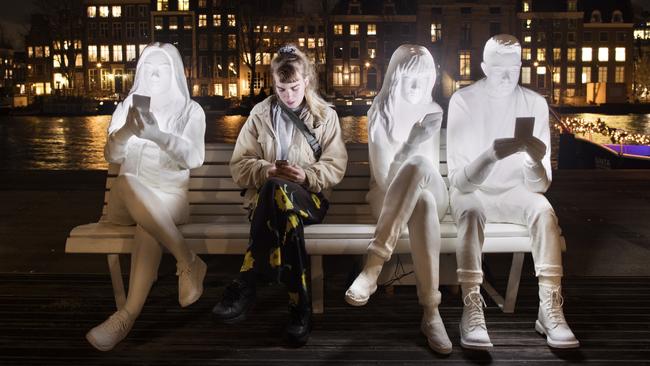
Co-founders and creative directors Lee Cumberlidge and Rachael Azzopardi conceived Illuminate to bring artists and innovators from around the world together with technical teams and cultural partners in Adelaide – pandemics notwithstanding.
“It’s a really different experience for South Australians at a different time of the year, coming out and embracing the cold,” Azzopardi says.
The Illuminate program will feature 150 installations, performances and events – including 41 world premieres – at various CBD sites.
It will also envelop a reinvigorated Festival of Ideas, in partnership with the University of Adelaide, as well as the new KINARA line-up of Indigenous artists at Tandanya, and include MAAD – a program of Music & Art After Dark.
”It’s not just about a light festival in winter – it’s about focusing on how technology generally intersects with various art forms,” Cumberlidge says.
Illuminate will also enable people to go behind the scenes of Adelaide’s creative industries, including internationally acclaimed animation and visual effects companies.
“We’re working with Monkeystack, we’re working with Rising Sun Pictures. It’s been really exciting for them too, working in a slightly different mode to normal,” Cumberlidge says.
“It’s also about exploring the city as you do that – we’re working with all of the cultural institutions, various galleries and all kinds of other public spaces to transform the city.”
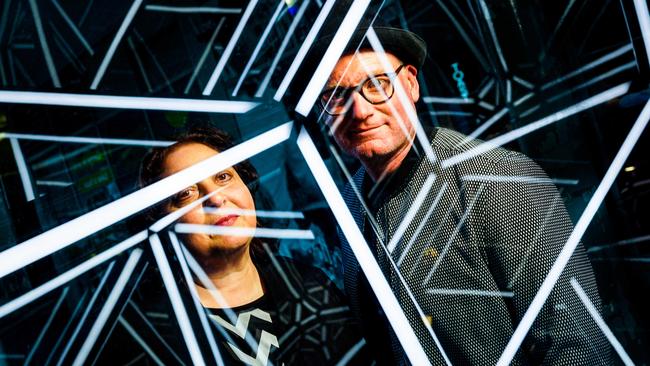
Azzopardi says many of the festival’s works are “experiential” rather than simply visual.
“A lot of the installations or big productions in the Gardens or the Zoo, or the Van Gogh Alive show, are really about immersing yourself in the work and experiencing it,” she said.
Full program details and tickets at illuminateadelaide.com
OUT OF AFRICA
One might expect Banksia, the title of Atong Atem’s video work for the Illuminate Adelaide festival, to refer to the flowering native plants which resemble her vivid designs and colour palette, or their namesake botanist Joseph Banks and associated themes about English colonisation.
However, the truth has a much more personal and troubling connection for the South Sudanese artist, who came to Australia as a six-year-old refugee and grew up on the NSW central coast.
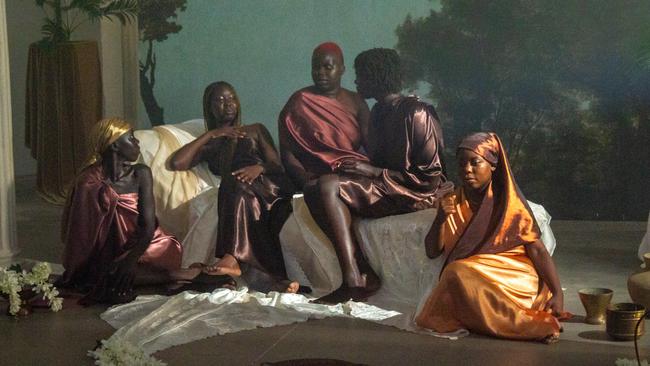
“It was literally just a reference to the Big Bad Banksia Men in May Gibbs’ books … and specifically my own personal relationship to White Australia,” the now 30-year-old Melbourne artist says.
“Obviously the Banksia Men were the villains, but I remember reading somewhere that she got the inspiration for it because she saw a bunch of men sitting in a tree – I assume it would have been dark-skinned men.
“She just thought that they looked horrendous and terrifying. But I remember as a child seeing it and thinking, oh, these people look more like me than these cute little chubby white babies in Snugglepot and Cuddlepie.”
Until now, Atem’s work has mostly consisted of still photography, playfully depicting fellow South Sudanese migrants in elaborate portrait settings, with vibrant layers of brightly patterned fabrics or surreal sci-fi makeup, to address broader issues of identity and belonging.
In that respect, Atem has referred to her body of work as an “ongoing self portrait”. That is also literally true of many images in which she herself is adorned with colourful face paint and floral arrangements, or swathed in 1950s-style gingham checks.
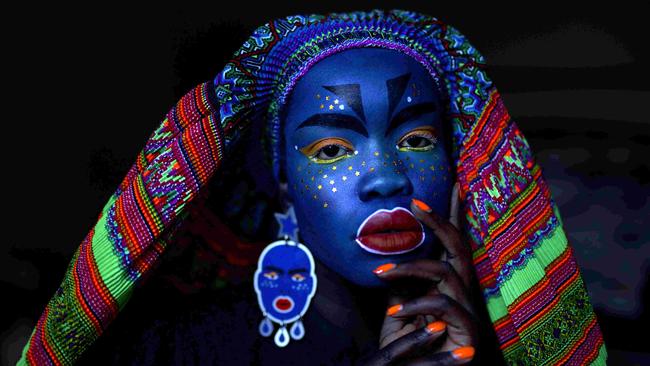
“Giving myself permission to just talk from my own perspective means that I can touch on larger subjects without feeling that I need to define them or be a historian in the way that I relate to them,” she explains.
Atem was excited to work on a more “grand scale” with Banksia, which will be shown on a giant video screen outside the Art Gallery of SA, even though some of her past work has been projected on much larger building facades.
“I was referring to the scale of the project itself, in terms of executing it: Having a cast and crew of close to 30 people in total,” she says.
“Usually I am working entirely by myself and I will photograph one or two, sometimes up to five other people at once.
“It was incredible to be able to work on something where I had the opportunity to hire people who are really expert in their own field. So I could just focus on the vision, and have an amazing DOP (director of photography), an amazing production designer, an amazing costume person.”
Atem initially majored in oil painting while studying at Sydney University.
“I came into photography from an art history perspective,” she says. That led to a specific interest in the ethnographic nature of early depictions of black people, both in scientific or cultural photographs and in classical European painting.
“I wanted to interrogate that research more through the act of taking photos. There’s a longer history of dissecting the way that non-European, non-white bodies and people are represented in figurative painting and art history … but I hadn’t really come across much with regards to photography.
“At the time, maybe 10 years ago, there seemed to be a real boom in the fashion industry showcasing black models and Asian models … it felt like an extension of ethnographic photography. That’s how it started. It was just a curiosity based on my own experiences of consuming certain kinds of media and certain kinds of art … that was not representative of the actual reality of the globe that we live in.”
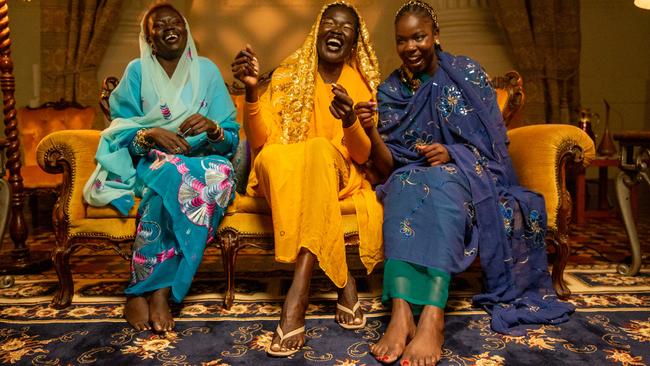
Much of the art history and the techniques taught in schools still draw heavily on European tradition, Atem said.
“With Banksia, it was spawned by the history of African migration to Australia, that has existed as long as European migration. Just because a thing is not depicted, doesn’t mean it wasn’t there – and just because you didn’t see it, doesn’t mean it didn’t happen.”
Many Australians might not know that there were people of African origin aboard the First Fleet when it arrived in Botany Bay in 1788. The artist’s interest was piqued while preparing an exhibition for Melbourne’s Immigration Museum.
“That’s where I discovered that black people had been coming to Australia as far back as the First Fleet. Some were free, some were not free, some were convicts – some were African-Americans who moved to the UK and then came here.”
Atem still describes herself as a South Sudanese woman and says she feels like an outsider “in a lot of different ways”, despite her distinctly Australian accent.
Part of that may be due to the sense of displacement Atem experienced as a refugee. “I definitely see myself as a displaced person, because we didn’t come here by choice, or as economic migrants.
“Because of our own sense of internal displacement in South Sudan, it is very hard to ignore the displacement of First Nations people in this country.
“In terms of the legacy of colonialism, it is hard to not question the validity of my existence in this country as an Australian person.”
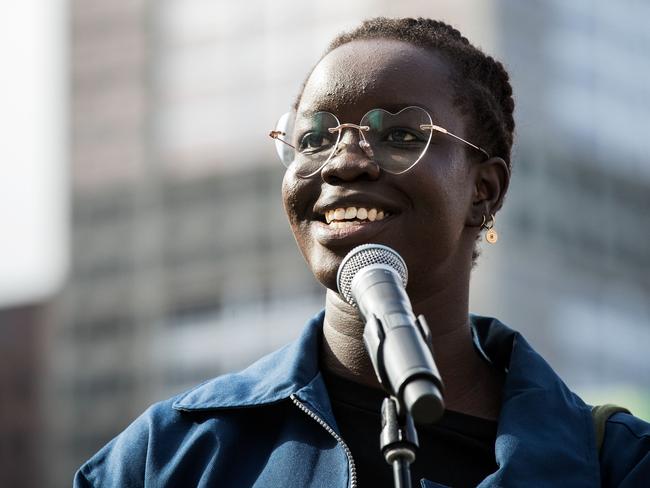
Atem was actually born in Ethiopia in 1991 to South Sudanese parents who had moved to escape war in their homeland.
“We had to go back three weeks after I was born, on foot, because of another war. It was chaos, all hell broke loose after then.”
Atem’s family spent time in a refugee camp in Kenya, before finally coming to Australia in the late 1990s.
In 2013 she moved to study in Melbourne, where there is now a large South Sudanese population which includes members of her extended family.
“I felt like I learnt a lot from the people that I photographed and the people that I often work with. They are not just hired models.”
One sequence in Banksia depicts five such South Sudanese women, draped in warm-hued fabrics, forming an almost classical Greek tableaus.
“I was more interested in positioning people and letting the camera move around them, rather than having the subjects engage with the camera,” Atem says.
“Definitely, tableaus was a word that I thought of … this sculptural, frozen-in-time kind of moment.”
Banksia is at the Art Gallery of SA from July 16 to August 1.
WELCOME TO THE FOREST OF DREAMS
In a forest outside Montreal, multimedia Canadian studio Moment Factory has been testing exactly how its atmospheric installations for Light Cycles will look when they are recreated by a team of Australian technicians half a world away at the Adelaide Botanic Garden.
“It’s been an ongoing effort in multiple iterations,” producer Mathieu Grainger says in a Zoom conference with creative director Gabriel Pontbriand from Montreal, in similar fashion to how much of the project has been pulled together across continents.
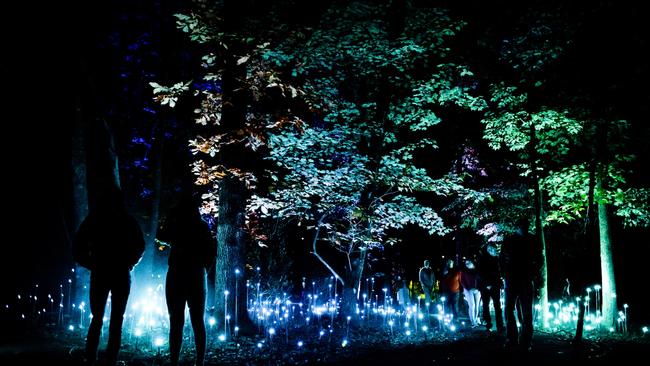
“Due to the pandemic and due to the fact that we can’t be on site, it’s pushed us as a company in the past year to rethink the way we work – to work remotely and to work in tandem, and to create affinities with like-minded people in the countries where we are working,” Grainger explains.
Illuminate Adelaide co-founders Rachel Azzopardi and Lee Cumberlidge first approached Moment Factory around the same time that the Covid-19 crisis began.
“We sent a series of tests that we want the local team to do, and they put them on. Then a week later we found ourselves here … we’ve got a space that we call the Forest Lab, about an hour and a half outside of Montreal in the Eastern Townships,” Grainger says.
“Our canvas is nature, so we are very fortunate to have access to this piece of land that has a very diverse ecosystem.
“We spent the greater part of a week on site, pre-programming two of the zones, recording music and audio, and working as a team out in the forest.”
These tests were matched with detailed information about the Adelaide location.
“The team that is working with us at Illuminate Adelaide spent countless hours walking the site, documenting, photographing and taking 360-degree video … to find the right features that we wanted to highlight.
“Technically we went as far as doing a 3D scan of one of the areas, so that our team can then work on the video mapping of this natural canvas here in our studio.
“It enables our technicians to then decide exactly where the equipment goes, how it is calibrated … and really imagine what this show will look like.”
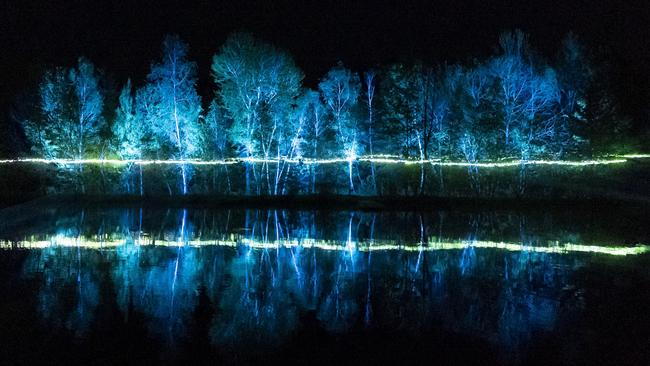
The core team from Moment Factory, including Grainger and Pontbriand, will travel to Adelaide and quarantine for two weeks before finally going on site at the Botanic Garden at the start of next month.
Pontbriand describes Light Cycle, which will feature seven installations along an almost 2km trail, as a “digital art exhibit” and says the advance work with the Adelaide team has been an incredible experience. The installations use lights, sound, video and special effects to amplify the voice of the natural world.
“We have a common vision. Obviously we have some artwork which we produce, but the opportunity to have this exchange with another team remotely, it’s amazing,” Pontbriand says.
“The pandemic forced us to create those kind of connections … now we can evolve together to present something that is going to be really unique.”
Like the artistic equivalent of real estate, location is everything.
“Light Cycle is about the connection between humans and nature, and those natural phenomenon. We enhance those phenomenon,” Pontbriand says.
“The site was so inspiring, the botanical gardens in Adelaide: We have some of the most beautiful perspectives. We have seven zones, each rich in nature. The goal is to create seven distinct artworks, representing the art of nature.
“What we want to do is give a voice to nature, through mixed media.
“We have the Australian Forest, we have a place called the Bamboo Grove, we have lake which we call Reflection Lake.”
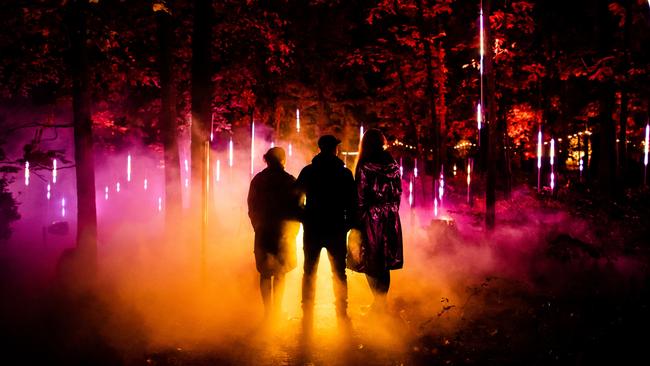
Nature installations are just one aspect of the work created by Moment Factory, which is celebrating its 20th anniversary.
“The company started as more of a night-life, multimedia designer for dances and afterparties, creating projections and such,” says Grainger.
“Everything came out of that. Montreal 20 years ago was a very fertile ground for creatives … Cirque du Soleil was coming into its own. We sort of spun out of that entertainment focus.
“Today, Moment Factory is a super-diversified company. We do major installations in international airports, we’ve got a team that focuses on cities and master planning of outdoor natural environments. Obviously we have the core, the team we protect at all costs, who work on the concerts and live shows.”
Moment Factory has created lighting and concert productions for everyone from Madonna to Billie Eilish and Jay-Z.
“Unfortunately everything came to a halt for a couple of months earlier this year, but we found a way to recreate ourselves there,” Granger says.
“With Billie Eilish, our team worked really hard to produce a few XR (extended reality) concerts online. We’ve done multiple television shows and galas.”
Pontbriand’s background is also in concert lighting design, having first gone on tour with bands at the age of 16 before joining Moment Factory about 18 years ago.
“We play with the particles of light … everything is about the synchronisation, to make sure we can create an emotion,” Pontbriand says.
“When you work in the theatre, it is a black box and it is always the same parameters. But when we discovered the forest … now we had the smell, we have the moon, we have the perspective. The possibilities are completely endless.”
Light Cycles is at Adelaide Botanic Garden from July 15 to August 1.
CREATURE CONSTRUCTS
With surprising speed, the unmistakeable black-and-white form of a giant panda inflates on a harbourside dock, dominating the sky over Melbourne’s Port Philip Bay.
Minutes earlier, it had been little more than a pile of heavy duty vinyl inside a warehouse at the Seaworks Maritime District at Williamstown, crammed among an Aladdin’s Cave of artefacts created by A Blanck Canvas, from futuristic vehicles and aquatic monsters to a gigantic, lion-like luminous puppet.
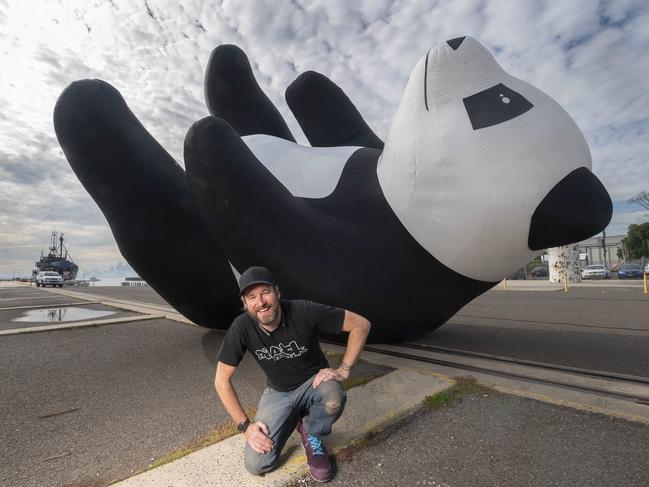
Across town, at A Blanck Canvas’s headquarters in Coburg North, lies another inflatable panda, this one with giant bamboo shoots which it will move back and forth toward its mouth.
The two will come together at Adelaide Zoo as part of Light Creatures, an after-dark experience that opens on July 8, a week ahead of the full Illuminate festival.
Company founder Joe Blanck was originally contacted by the Zoo when it had the idea to mount a lantern festival.
“They’d spoken to a couple of companies and it was going to be more traditional Chinese lanterns,” Blanck says.
After discussions about the different materials and techniques used by A Blanck Canvas, the event shifted direction “into foam fabricated and inflatable large-scale creatures”.
The timing of Light Creatures made it perfect for the debut Illuminate program.
Blanck’s history with giant puppets and animatronics goes back to the original Walking with Dinosaurs arena spectacular, developed by Creature Technology Company, with which he also worked to develop the ape star of recent Broadway musical King Kong.
All of these helped pave the way for Light Creatures.
“Both the pandas have a moving mechanism – there’s a rolling panda which rolls on its back, so it has a steel structure inside it which doubles as a counterweight and it also has an electric motor in the mechanism,” Blanck says.
“The other one is a sitting panda … it’s eating bamboo so it moves its arm up and its head down.”

All of the installations at Adelaide Zoo will be internally lit with LED lights and feature custom composed soundscapes.
“There are two giant giraffes – which we are calling the Giraffe Arch – as an entry way,” Blanck says.
Indigenous artists Jack Buckskin and Elizabeth Close, and composer Mark Cole Smith, have collaborated to create a 27m long skink installation.
“Jack has managed to get this story from the elders down on paper … it’s a South Australian story from the Kaurna people. He will narrate it, played with a soundscape and we’ve wrapped the skink in Elizabeth’s artwork.
“The skink lights up and moves as well, and changes colours, so that’s going to be a really cool piece.”
Not all of the Light Creatures works are inflatable.
Those in an elaborate ocean scene have been fabricated from a special, translucent foam.
“Finally, there’s the Underwater Wonderland – that’s probably the biggest, most complex piece, which has 10 giant jellyfish on DMX winches, so they move together in unison with the music.
“Then there’s 10 giant coral, which are about 3m tall, and five swimming fish and a giant anglerfish which is 4m long. They are all illuminated and internally lit, so you will feel like a tiny creature in this giant Underwater Wonderland.”
Light Creatures is at Adelaide Zoo from July 8 to August 1.
ECLECTIC LIGHT ORCHESTRA
Ethereal notes build into a soothing, almost hypnotic symphony as audience members interact with a strange assemblage of alien characters in Airship Orchestra.
Individual creatures that resemble quirky sea urchins ebb and glow, emitting different sounds as their pixelated digital eyes open, blink and follow passers-by.

It’s as if a bunch of larger-than-life, pop vinyl figurines have suddenly come to life to form their own version of the Electric Light Orchestra or Jefferson Starship.
Airship Orchestra was the brainchild of Melbourne-based design company ENESS and its creative director Nimrod Weis.
“I have always been fascinated with putting eyes on everything – just bringing things to life. I’ve put blinking eyes on canvases, tabletops, chairs – even pillows, actually,” Weis says.
“It’s a continuing thing for me, this idea of making characters out of more abstract or unusual forms. They are not any one, specific creature.”
Previous iterations have been mounted in Washington DC and Shanghai, but Weis says the inflatable installation has continued to be refined.
“This is a self-initiated project … I had this idea of creating an orchestra, some type of sculpture, a public artwork that is based around interaction with music,” he says. “It’s this idea of an orchestra coming together, and people being able to influence the characters as well. Their location is influencing light and sound.”
Along with another ENESS inflatable work, the rainbow-like Sky Castle, it will be among more than 40 installations in City Lights at three precincts across Adelaide as part of the Illuminate festival.
Airship Orchestra is the more meditative work, while Sky Castle is more rhythmically upbeat.
“In the wake of Covid … the initial idea was that after every storm there is a rainbow,” Weis says. “Sky Castle reflects that with those arches being more rainbow-like and more architectural.”
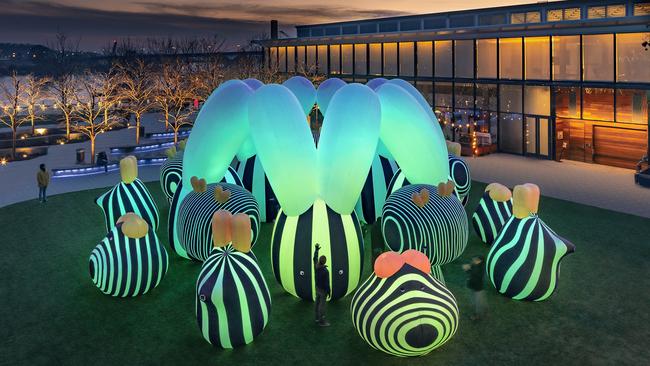
Each character has its own personality, but makes up part of the collective work.
“To me, the overall form is almost like this 3D mandala – there is rhythm and repetition, but it evolves and changes throughout,” Weis says.
“The intention is that each character kind of follows the choir principle of a tenor, a baritone, a soprano.
“That’s the amazing thing with ENESS is that we are a collective, so we have musicians, industrial designers – I myself was a graphic designer in the past. There are so many disciplines that we have internally, so it is not just one mind.
“Even with the music, it was composed internally. There’s a lot of complexity to it, to make it interactive.
“These notes are playing in real time, and then as people interact with it, the sound evolves. To do that with choir members has been really complex.”
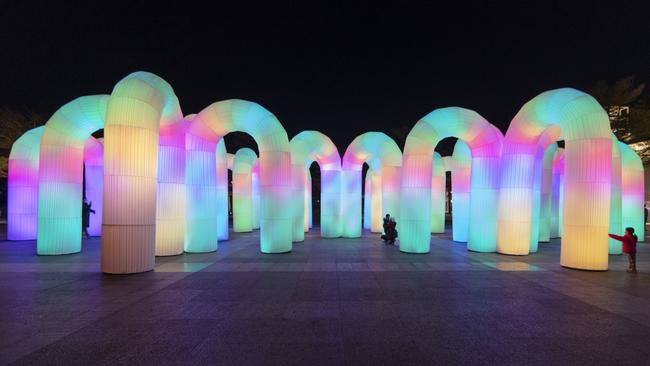
On the other hand, Sky Castle plays a different sound as people pass through each arch.
“It plays more like a drum machine, almost, where you can put certain notes in a particular time, and it rhythmically plays throughout.
“In every one of these, we have been exploring how to create more generative, interactive moments where people get to understand that they are influencing it.”
One of the concepts ENESS explores is called “Happiness Architecture”.
“It symbolises, to me, the idea that we can bring into our public realm these spaces that create happiness, and therefore a connection between people as well,” Weis says.
“When people walk through this installation, they can’t help be anything but open, bump into someone, smile and share a moment.”
The free City Lights installations will span the CBD at night from July 16 to August 1. Details at illuminateadelaide.com




